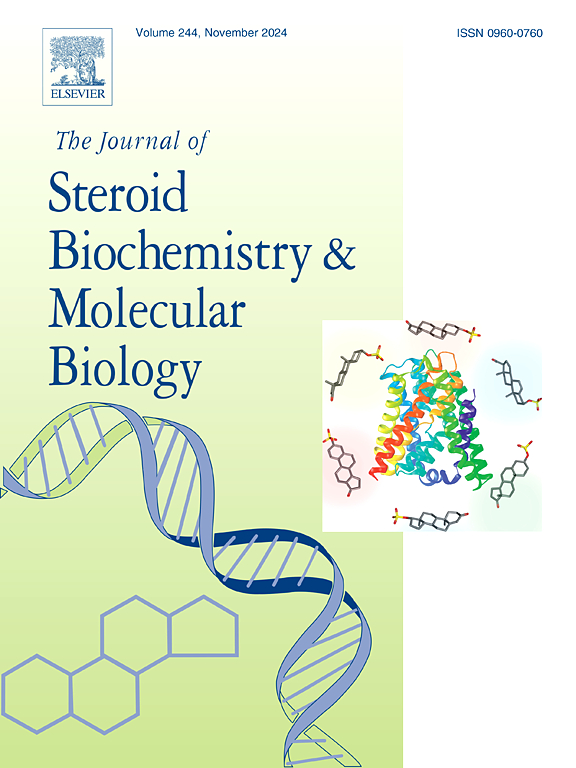Inhibition of 14–3-3 protein enhances steroid hormone production and oxidative stress in mouse ovary: Implications for apoptosis regulation
IF 2.5
2区 生物学
Q3 BIOCHEMISTRY & MOLECULAR BIOLOGY
Journal of Steroid Biochemistry and Molecular Biology
Pub Date : 2025-09-28
DOI:10.1016/j.jsbmb.2025.106869
引用次数: 0
Abstract
The ovary is a primary reproductive organ where the fine balance between steroidogenesis, oxidative stress, and apoptosis governs female reproductive health. A highly conserved protein, 14–3–3, is known to influence steroid biosynthesis, redox balance, and cell survival; however, its integrative role in ovarian physiology remains poorly defined. This study investigated the consequences of pharmacological inhibition of 14–3–3 protein using BV02 in in vitro cultured mouse ovaries. Immunohistochemical analysis revealed strong expression of 14–3–3 in granulosa cells, with moderate expression in oocytes and theca cells. In the BV02-treated ovary (100 μM), there was significant elevation in the levels of ovarian progesterone, testosterone, and estradiol, indicating enhanced steroidogenesis. However, the treated ovaries showed decreased activity of catalase and superoxide dismutase (SOD), along with increased lipid peroxidation (TBARS), indicating increased oxidative stress. Western blot analysis showed downregulation of the anti-apoptotic protein Bcl-2 together with elevated levels of the pro-apoptotic protein Caspase-3, signifying a molecular shift toward apoptosis. Correlation analysis further established strong associations (p < 0.05) between oxidative stress markers and apoptotic regulators, highlighting a mechanistic link between impaired antioxidant defenses and apoptosis. These findings reveal that 14–3–3 protein acts as a dual regulator of ovarian physiology by restraining steroid hormone production in addition to maintaining redox balance and cell survival. Disruption of this equilibrium may lead to pathological states such as polycystic ovary syndrome (PCOS) and ovarian cancer. Thus, this study provides novel mechanistic insights into the regulatory role of 14–3–3 protein in the ovary and underscores its potential as a therapeutic target in reproductive disorders.
14-3-3蛋白抑制小鼠卵巢类固醇激素产生和氧化应激:凋亡调控的意义。
卵巢是主要生殖器官,甾体生成、氧化应激和细胞凋亡之间的良好平衡支配着女性生殖健康。已知高度保守的14-3-3蛋白影响类固醇生物合成、氧化还原平衡和细胞存活;然而,其在卵巢生理中的综合作用仍不明确。本研究探讨了BV02对体外培养小鼠卵巢14-3-3蛋白的药理抑制作用。免疫组化分析显示14-3-3在颗粒细胞中强表达,在卵母细胞和卵泡细胞中有中等表达。在bv02处理的卵巢(100μM)中,卵巢黄体酮、睾酮和雌二醇水平显著升高,表明类固醇生成增强。然而,处理后的卵巢过氧化氢酶和超氧化物歧化酶(SOD)活性下降,脂质过氧化(TBARS)升高,表明氧化应激增加。Western blot分析显示,抗凋亡蛋白Bcl-2下调,促凋亡蛋白Caspase-3水平升高,表明细胞向凋亡的分子转移。相关分析进一步确立了强关联(p
本文章由计算机程序翻译,如有差异,请以英文原文为准。
求助全文
约1分钟内获得全文
求助全文
来源期刊
CiteScore
8.60
自引率
2.40%
发文量
113
审稿时长
46 days
期刊介绍:
The Journal of Steroid Biochemistry and Molecular Biology is devoted to new experimental and theoretical developments in areas related to steroids including vitamin D, lipids and their metabolomics. The Journal publishes a variety of contributions, including original articles, general and focused reviews, and rapid communications (brief articles of particular interest and clear novelty). Selected cutting-edge topics will be addressed in Special Issues managed by Guest Editors. Special Issues will contain both commissioned reviews and original research papers to provide comprehensive coverage of specific topics, and all submissions will undergo rigorous peer-review prior to publication.

 求助内容:
求助内容: 应助结果提醒方式:
应助结果提醒方式:


